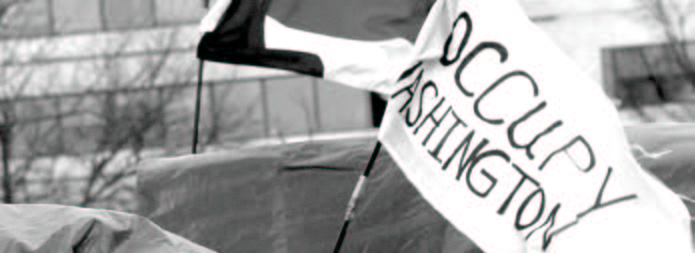Life has gotten increasingly hard for the protesters camped in McPherson Square. The cold weather has caused their numbers to dwindle. Donations of food, supplies, and money have all shrunken considerably. The makeshift tea and coffee shop has been abandoned.
Nerves have been strained at times. The latest challenge came in the form of a standoff with police over a two-and-a-half story blue “Tent of Dreams” the protesters pitched over the statue of Major General James B. McPherson in the center of the park. At the time Street Sense went to press, US Park police had given the protesters notice that the tent needed to be removed. But protesters said they planned to remain in the park.
It was just the latest of many struggles faced in the nearly five months since the first of the Occupiers staked their claim on the square, renamed it Liberty Plaza, and made a public statement of their discontent with the direction of the nation and the world. .
It seems like a long time ago now, when a handful of people—some of them college students—sat on the autumn grass discussing strategies for expanding the protest. A large pile of cardboard protest signs lay nearby, ready to be raised. The goals were wide ranging. “Generally unsatisfied,” read one. “We will take back America from the legal financial mob,” read another. ““Devolvemos Nuestra Voz!” “We are Here Until it Works.”
Meanwhile Occupy Wall Street had only just begun garnering serious attention from mainstream media outlets. And unlike Zuccotti Park, Liberty Plaza was not yet officially an encampment. As one organizer explained, at that point there were still too few protestors to resist the police and establish an overnight presence. So instead, a dedicated few slept on the sidewalk and under store awnings surrounding the park.
But by mid-November, the situation had changed. In just a few weeks, the park had become packed with tents—even one teepee. The protestors’ daily demonstrations—called “actions”—had grown in ambition. On Nov. 17, about 100 protestors formed a human chain across the Francis Scott Key Bridge, leaving traffic funneling slowly on each side. No arrests or injuries were reported, and for a time, it seemed that relations between police and occupiers would remain fairly positive.
Then, on Dec. 7—the same week that protestors in New York were evicted from Zuccotti Park—hundreds gathered on K St., NW to protest corruption within the lobbying industry, resulting in a tense standoff with police. More than 70 people were arrested.
Early in January. the protestors rallied in front of the Capitol, chanting phrases like “Congress sold us out.” Four protestors were arrested, and several who took part in the rally claimed that they observed unprovoked violent police force.
“Police were actually hitting people,” said one protestor, who identified himself as Harmony.
Now, as the McPherson encampment reaches its five-month mark, some protesters face civil citations.
Worries about hunger and security have made life harder. Conflicts have broken out. Energy seems to be flagging. “During the day, there’s not much food,” said Melissa Miller, who has been sleeping at the encampment for just under two months.
According to Miller, who also camped in Zuccotti Park until it was raided, sleeping bags and winter gear are also difficult to find on-site. Despite the slump in supply donations, however, Miller added that coffee shops and restaurants continue to donate food each evening.
Among the many challenges facing protestors in Liberty Plaza is security, though a small “de-escalation” group is charged with mediating conflicts among occupiers and (often intoxicated) passers-by. Petty theft also continues to trouble the encampment.
“Every committee was issued an iTouch,” said Mike, who declined to reveal his last name, “but now they’re all gone.” Mike traveled down to Occupy DC after Occupy Baltimore was raided in December.
The mood in McPherson Square, say protestors, has also changed. Actions are no longer daily and media coverage has fallen.
“There isn’t enough of a sense of urgency,” said a man who identified himself as Scout. “We need to be having an action every single day.”
But protestors have not given up hope. Petty cash donations range between $60-$140 each day, according to Mike.
Late in January, the U.S. Park Service announced that citations would be issued to all those violating park’s the no-camping ban. In response, many protesters swiftly removed their sleeping bags from the encampment, leaving behind a handful of empty tents. The kitchen tent was also hollowed out, though the library tent remained.
But few of the protesters said they fear that police will force the encampment to shut down.
“There’s a really strong legal precedent allowing people to camp out here in DC,” said Camillo Brokaw who before Occupy DC spent several months in Occupy Albuquerque, which has since been raided.
Brokaw added that he and other protestors are prepared to remain onsite, even if police do step up enforcement.
“I think a large percentage of people are going to hold their ground,” he said.
According to Brokaw, the protestors are determined to maintain a presence in McPherson Square until the spring, when they believe participation will return to its earlier level, if not increase.
Until then, the protestors will continue to hold regular committee meetings and to engage any passers-by who may be interested in their cause.
“I don’t think I’ve been here a day without talking to someone outside the protest,” said Brokaw.







